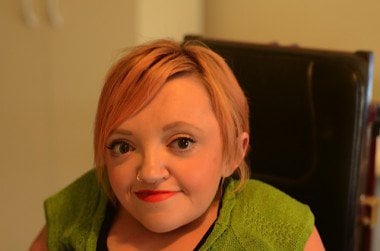
Are child models with Down Syndrome really a great win for diversity?
A nine-year-old girl named Kayla Komlaski has just made headlines as Gap’s first ever model with Down syndrome. The news comes hot off the back of another story about Cora Slocum, a four-year-old girl with Down syndrome, who has appeared in an ad campaign for shoe label, Livie & Luca.
Like most people, when I first read these articles and saw the photos of Cora’s beaming face, my initial response was “Aww, what a gorgeous kid! And what a stunning, joy-filled photo. Just lovely.”
Cora generated the hashtag #I’mGoingBackToSchoolToo and other kids posted photos of themselves. (Post continues after gallery)
#ImGoingBackToSchoolToo
But before hitting the ‘share’ button, I stopped. And I thought back to a conversation I once had with disability activist, Stella Young.
Stella was talking to me about an emerging trend where a number of children and babies with Down syndrome had been touted as the Next Big Thing in modelling.
There was 10-month-old baby, Valentina Guerrero, who was described as the “favourite swimsuit model ever” and Natty Goleniowska, a seven-year-old girl who was selected to star in the Sainsbury’s Back to School campaign. More recently we’ve seen Louis Killick, a six-year-old boy with Down syndrome, Izzy Bradley a two-year-old model with Down syndrome, Seb White, a seven-year-old boy with Down syndrome, Franceca Griffiths, a two-year-old baby with Down syndrome, and others.
Stella explained to me that while on the surface this might look like cause to celebrate, deep down, there was nothing truly progressive or revolutionary about any of it, so long as virtually all the models with disability continued to (1) have Down syndrome, (2) be infants or children.
Top Comments
I like everything about the models with down syndrome news story, except for one thing. The fact that it's modelling. An industry built entirely on your worth as a coathanger. I would never encourage my daughter (with down syndrome or without) to pursue modelling. A tiny, tiny percentage make an excellent career of it, but for the vast majority it is terribly exploitative and often a very short lived career. It celebrates nothing about a woman that makes her wonderful - her intellect, her opinions, her personality. By encouraging any girl into it we are encouraging her to focus solely on what's on the outside, and I don't think that's good for anyone.
You should check out Madeline Stuart.... Kind of exactly what you are asking to happen. Like her on Facebook and you get to see what's happening with her and her career